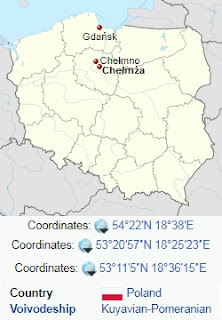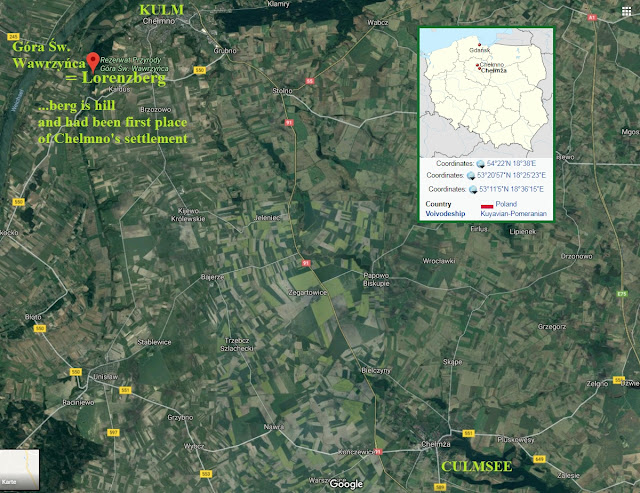Origin of ... name(s)
onomastics / Onomastik / Onomasiologie
 |
| Polska map |
...and the Lake...
 |
| heraldic figures Kulmsee, Chelmza, Kulm |
a compilation of facts / data /
exchange of ideas / flights of thought / brainwaves ...
exchange of ideas / flights of thought / brainwaves ...
a millennium ago...:
fortress on hilltop became town with resettlement and expansion towards lake nearby,
Synopsis
Synopsis
Chełmno
satellite: https://goo.gl/maps/jjHv6nzyrKn
 |
| Chelmno Chelmza Culmsee LAKE area |
Chełmża
satellite: https://goo.gl/maps/YRuaYcMC5wy
What about the orign of Kulm...?
Was ist der Ursprung von Culm...?
...first this note: this webLog arose from a discussion, well, a brainstorming at a facebook group "...Culmsee..." and thanks to Poul und Kai having inspired to this read more and here starts an enterprise to find answers in explanation...:
...zuerst diese Anmerkung: dieses webLog entstand aus einer Diskussion, besser einem Brainstorming innerhalb einer Facebook-Gruppe „...Culmsee...“ und danke an Poul und Kai im Inspirieren auf mehr lesen und hier beginnt ein Vorhaben, Antworten zu finden im Erklären...:
Kulm oder Culm als Name oder Begriff ist ein sog. Toponym, also griechisch ónyma, ein Name, genauer ein geographischer Name (gr. tópos).Folglich suchen wir im Verbund Geowissenschaft / Namenskunde.
Der Namensgeber von Culmsee ist folglich sekundär à la Culm am See [vereinfacht].
Und die Stadt (ehemals) Culmsee, heutiges Chełmża in Polen, ca. 150 km südlich von Danzig gelegen, 20 km nördlich von Thorn, Chełmża selbst bekam 1251 Stadtrechte, also etwa zwei Jahrzehnte nach Chełmno (1233), wenngleich das alte Kulm Anfang 12__ mit dem Bistum Kulm gegründet worden war.
mehr Details hier / more details here: https://de.wikipedia.org/wiki/Che%C5%82mno
weniger Details / fewer details at: https://en.wikipedia.org/wiki/Che%C5%82mno
Kulm or Culm being name or term is a so called toponym, thus Greek ónyma, a name, exactly a geographic name (Greek tópos).
Therefore we do research at composite geoscience / onomastics.
And the town of (former days) Culmsee, today's Chełmża at Poland, located approx. 150 km south of Gdańsk, 20 km north of Toruń, itself in 1251 got city rights, thus two decades later than Chełmno (in 1233), though the old Kulm in early 12__ had been founded with the Bishopric Kulm.
im Lateinischen steht culmen für Gipfel, Kuppe, Spitze.
Ornithologie / ornithology (zoology):
dorsal ridge of a bird's bill / ein Teil des Schnabels vom Emu
ridge implicates hills... / Bergrücken einbezieht Hügel
alles ist mit allem in der Wissenschaft verbunden /
everything is connected with everything in science
>>...people about with the surname Culmer/Kulmer...<< [mentioned fb]
is easy to explain because "Kulm" is name of a town, too, nearby Kulmsee = Culmsee at its homonymous lake and in being eponym SEE = LAKE CulmLAKE = KulmLake [K = C because of German's former days kind of writing latin C in German K].
town of Chelmno (approx. 30 km north of Chelmza [where I stopped in 2001, too])
https://de.wikipedia.org/wiki/Che%C5%82mno
...in reading of a Kulmer with ending -er is typical designation for a human who comes from a such called lacation, for that such ending is possible in its language, e.g. like from (city) Hamburg an (inhabitant) Hamburger, from (city) Köln (= Cologne) an (inhabitant) Kölner or (city) Berlin an (inhabitant) Berliner.
...by the way (inhabitants) Hamburger/Berliner here is a human, no food ;-) approximate to "namesake" but completely different, just now humas ;-)
...was ist mit dem Nachnamen Culmer / Kulmer...
ist einfach zu erklären, weil „Kulm“ Name einer Stadt ist, ebenso in der Nähe Kulmsee = Culmsee am gleichnamigen See und als Eponym (= Namensgeber) See = Lake CulmSee = KulmSee [K = C, weil dies beim Schreiben in der Vergangenheit im Deutschen gebräuchlich war, auch wegen der lateinischen Schreibweisen].
...von einem Kulmer lesend mit der Endung -er, ist dies typische Bezeichnung eines Menschen, der von solch einem benannten Ort kommt, für den solch Endung in dieser Sprache möglich ist, z.B. wie von (Stadt) Hamburg der (Einwohner) Hamburger, von (Stadt) Köln der (Einwohner) Kölner oder von (Stadt) Berlin der (Einwohner) Berliner. nebenbei sind die (Einwohner) Hamburger / Berliner hier menschlich, kein Essen ;-) ...etwa wie „Namensvetter“, aber komplett verschieden, eben wie Menschen ;-)
research
https://de.wikipedia.org/wiki/Special:Search?ns0=1&search=kulmer&searchToken=bpvsqix7zmn0q043xvusun41l
https://de.wikipedia.org/wiki/Culmsee
forwards to / is linked to
which was created by me :-)
or https://en.wikipedia.org/wiki/Draft:Jezioro_Che%C5%82m%C5%BCy%C5%84skie
Jezioro Chełmżyńskie is the Polish name of a lake located at the town of Chełmża in Toruń County, Kuyavian-Pomeranian Voivodeship, Poland. Both, town and lake former days (up to 1945) were named in German: Culmsee. The ending ...see means Lake / Jezioro. Therefore in 1251 the lake became eponym of the town.
The lake is up to 6 km long, width up to 0,5 km, up to 27 m deep, has an area of 2,7 km².
Der Jezioro Chełmżyńskie (ehemals: Culmsee) ist ein See, der an die polnische Stadt Chełmża in der Woiwodschaft Kujawien-Pommern heranreicht. Mit seinen zwei nordwestlichen Ausläufern liegt er auf dem Stadtgebiet. Dieser See, der Culmsee, wurde 1251 zum Namensgeber der Stadt.
Der See ist ca. 6 km lang und bis 0,5 km breit. Er ist bis zu 27 m tief und hat eine Fläche von ca. 2,7 km².
Jezioro Chełmżyńskie at Chełmża
https://de.wikipedia.org/wiki/Che%C5%82m%C5%BCa
historical landscape named Kulmer land (= area) at EN.Wikipedia linked to Chełmno Land
https://de.wikipedia.org/wiki/Kulmerland
erklärt,
dass „Kulm“ aus dem Slawischen stammt, nämlich dem Wort „chlm“, welches einen Hügel bezeichnet und quasi eingedeutscht als „Kulm“ übernommen wurde. Als Ortschaft „Kulm“ lag es ursprünglich am nahegelegenen „Lorenzberg“ (= Góra Św. Wawrzyńca).
explains
that "Kulm" stems from slavish "chlm" that denotes a hill and quasi had been germanized as "Kulm". As village "Kulm" originally lay at proximate "Lorenzberg" (= Góra Św. Wawrzyńca).
...but what about hill or hills? well Chelmza's/Chelmno's area actually is plain land in driving through...!
[self experienced in 2001]
Was ist mit Hügel oder Hügeln? nun, Chełmża's / Chełmno's Umland ist flaches Land beim Hindurchfahren...!
search results: Kulm (Geographie)
>>Kulm steht allgemein für den Gipfel eines Berges, speziell für einen Kegelberg oder eine Kuppe. ...<< according to
https://de.wikipedia.org/wiki/Kulm_(Geographie)
https://de.wikipedia.org/wiki/Kulm_(Geographie)#Polen
e.g. Chelmno
searching for "Kulm" at
https://en.wikipedia.org/wiki/Kulm
displays various but
look at
https://en.wikipedia.org/wiki/Culm
with disambiguation
or at
https://en.wikipedia.org/wiki/Kulm
but interesting "2nd" "Kulm (town)
https://de.wikipedia.org/wiki/Kulm_(Saalfeld)
located nearby Saalfeld (Thüringen) = Germany: the Free State of Thuringia
explaining a 481 meters high hill ...
well, the roots might go deeper... in time, before our known ancestors.
 |
| towns Celle / Altencelle at Germany (for comparison only) |
another direction, 30km too, is located town of Bromberg and ...berg means ...hill (today's Bydgoszcz).
...and at Lorenzberg since 7th century settlements are known. bishopric / diocese Kulm [German: Bistum Kulm] founded in the land of the hills at river Vistula (German: Weichsel). and that's too another reason to keep the name Kulm... reasonned by topographical area of political and tactical interest Kulm... and the Hanseatic League (German: Hanse) in 13th century had been of importance there, too, and remained over the centuries the towns name's dimension(s).
Influences of centuries' trade and church and striving for power spread furthermore than Kulmerland... but reasons the steadiness...!
...this town(s) area saw many wars during last millenium (knights, crusades, ...).
...and the hill / Berg named Lorenzberg remains...
 |
| Chelmno Chelmza with lake and their "hills" area former days... |
(Góra Św. Wawrzyńca) had been the first location of Kulm/Culm/Chelmno in a distance of a few kilometers only.
Zusammen mit Elbing und Thorn war Danzig die führende preußische Hansestadt.
https://de.wikipedia.org/wiki/Danzig#Hansestadt
https://en.wikipedia.org/wiki/Gda%C5%84sk
 |
| Hanseatic League [German: Hanse] |
river [German] Weichsel = Vistula [geographic]
https://goo.gl/maps/jr34ovPikhD2
 |
| road sign Chelmno |
https://pl.wikipedia.org/wiki/Che%C5%82mno
is told that "gród Chełmiński" / Chełmiński Burg = castle had been on top of St. Wawrzyńca at today's village of Kałdus where at 11th century a fortress had been built...
https://pl.wikipedia.org/wiki/Che%C5%82mno#Historia_Che%C5%82mna
górze św. Wawrzyńca
 |
| hill area: Chelmno Kaldus at Vistula |
this link from Chełmno PL "Historia"-site the hill:
https://pl.wikipedia.org/wiki/G%C3%B3ra_%C5%9Awi%C4%99tego_Wawrzy%C5%84ca_(Ka%C5%82dus)
just watch this great proof at Wikipedia of the hill !
Góra (Polish) = Berg / Hill
explaining "... Góra św. Wawrzyńca (Lorenzberg) ..."
telling of an elevation / rise [geological] at Early Middle Ages ... at Vistula ... early Romanesque (architecture) basilica from first half of 11th century ... (translated excerpt from Wikipedia)
averment: here's the proof picture from "Rezerwat",
„...Geländeerhöhung ... im frühen Mittelalter ... an der Weichsel ... frühromanischen Basilika aus der ersten Hälfte des 11. Jahrhunderts ...“ (Wikipedia, Auszug)
Świętego = heilig ... / holy, scared ...
Wawrzyńca = Lorenz / Lawrence
according to "Pons" and
https://pl.wikipedia.org/wiki/Wawrzyniec_z_Rzymu
Wawrzyńca = Lorenz / Lawrence
according to "Pons" and
https://pl.wikipedia.org/wiki/Wawrzyniec_z_Rzymu
Hope you enjoyed this compilation :-)
all maps from "Google Maps"




Keine Kommentare:
Kommentar veröffentlichen